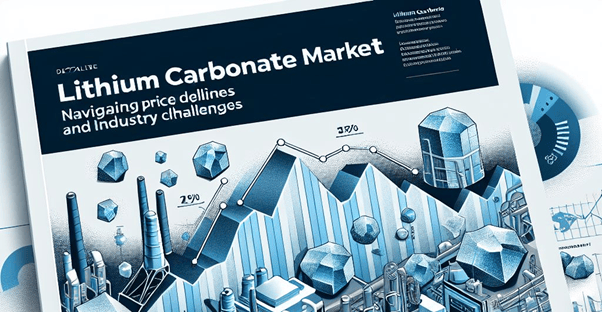Lithium Carbonate Market: Navigating Price Declines and Industry Challenges
Xuan-Ce Wang
12/9/20243 min read


Abstract
This report analyzes the recent trends and challenges in the lithium carbonate market, focusing on the steady price decline from RMB 82,700 to RMB 76,800 between November 20 and December 9, 2024. It highlights the structural issues in the lithium value chain, including overcapacity in the midstream lithium salts sector, supply bottlenecks in mining, and consolidation in battery manufacturing. A detailed breakdown of production costs reveals the impact of rising input expenses, such as spodumene concentrate and auxiliary materials like soda ash and sulfuric acid. The report evaluates the investment potential of the lithium carbonate market, assigning a cautious short-term score of 50/100 due to volatility and a positive long-term score of 75/100, given the strategic importance of lithium in renewable energy and electric vehicle industries.
1. Recent Price Movements
1) Market Context
Lithium carbonate prices have shown a steady decline, with recent data indicating a decrease from RMB 82,700 (November 20) to RMB 76,800 (December 9), marking a 7% drop. This downward trend, while appearing modest, signifies a significant market shift from the peak prices of RMB 200,000, experienced in earlier bullish phases.
2) Implications
For Long-Term Investors: The price drop challenges the expectations of those who anticipated continued growth, raising questions about lithium carbonate's ability to recover to the peak of RMB 87,600.
For Industry Stability: Falling prices introduce uncertainty and exacerbate competitive pressures across the supply chain, particularly for midstream producers.
2. Midstream Challenges in the Lithium Industry
1) Upstream: Lithium Mining
Dynamics: The supply side faces natural bottlenecks due to the scarcity of high-grade mines and the high costs associated with lower-grade mining. These issues are compounded by slow returns on brine resource investments.
Sustainability: Producers of low-grade, high-cost lithium are particularly vulnerable to sustained low prices.
2) Downstream: Lithium Batteries
Overcapacity: Similar to mining, the battery segment has grappled with overproduction. However, the sector benefits from higher technical barriers, allowing for consolidation.
Market Leaders: Companies like CATL demonstrate resilience due to innovation and efficiency, capturing significant market share.
3) Midstream: Lithium Salts
Price Competition: The homogeneity of lithium carbonate production fuels intense price competition.
Vertical Integration: Many midstream players are investing in upstream resources to achieve greater control over the supply chain, pressuring smaller companies.
3. Production Costs of Lithium Carbonate
1) Lithium Concentrate Costs:
Requirement: 7.5–8 tons of 6%-grade spodumene concentrate per ton of lithium carbonate.
Current Price (December 9): Untaxed price at RMB 5,751/ton; taxed price at RMB 6,500/ton.
Contribution to Production Cost: RMB 48,800–RMB 52,000 per ton.
2) Soda Ash and Sulfuric Acid:
Soda Ash: Approximately RMB 1,420/ton.
Sulfuric Acid: RMB 420/ton.
Contribution: Combined cost of RMB 4,016 per ton.
3) Other Costs:
Fuel and Power: RMB 10,300 per ton.
Depreciation: RMB 6,300 per ton.
Slag Disposal: RMB 4,200 per ton.
Labor: RMB 3,700 per ton.
Total Miscellaneous Costs: RMB 24,200 per ton.
Overall Production Costs
Cash Cost: RMB 72,300 per ton.
Comprehensive Cost: RMB 78,600 per ton.
4. Investment Perspective
1) Short-Term Outlook
The declining price trend and intense competition in the midstream segment suggest continued price volatility. Short-term investors should be cautious, as market sentiment appears bearish, and further declines may occur.
2) Long-Term Outlook
Long-term investment prospects depend heavily on:
The global shift to renewable energy and electric vehicles (EVs), which could drive demand for lithium batteries.
Vertical integration among producers, allowing better cost control and supply chain management.
5. Investment Scoring
1) Short-Term Investment Score: 50/100
Neutral stance due to price volatility and near-term uncertainties.
2) Long-Term Investment Score: 75/100
Positive outlook driven by the strategic importance of lithium in energy transitions and the potential for industry consolidation to stabilize prices.
Investors should monitor pricing trends, cost structures, and technological innovations within the lithium value chain to make informed decisions.








